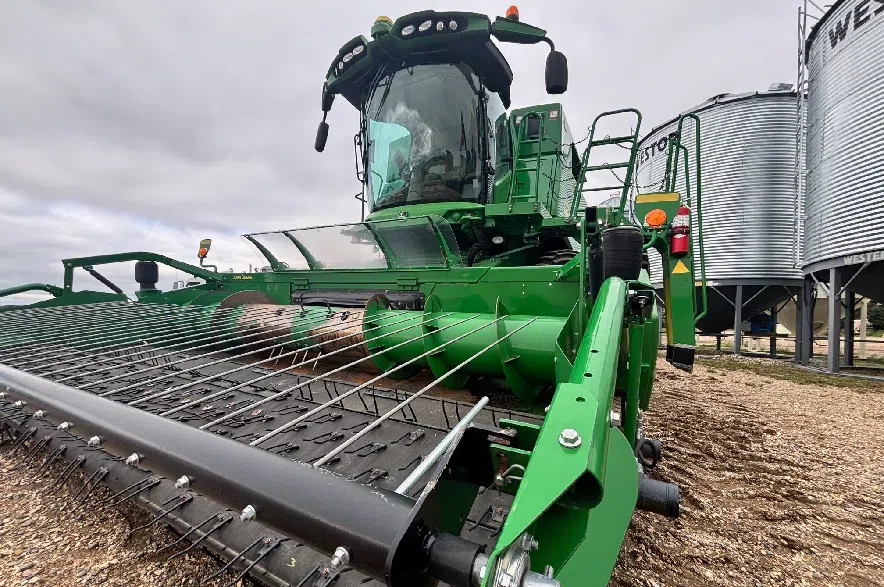Harvest in Saskatchewan is 68 per cent complete, up from 53 per cent a week ago, but a number of factors are slowing down producers’ progress as they work to get the 2025 crops into the bin.
According to the weekly crop report from the Saskatchewan Ministry of Agriculture, which covered the week ending on Monday, producers are making good headway on this year’s harvest, but progress is still lagging behind the five-year average of 83 per cent and the 10-year average of 72 per cent. The ministry said high humidity and rainfall stalled progress in parts of eastern Saskatchewan and delayed the start of some harvest operations in the west.
Read more:
- Harvest passes halfway point, but producers slowed by precipitation: Crop report
- Beef prices to stay high for ‘next couple of years’: Cattle association
- Mounties warn of misinformation as investigation into highway shooting continues
“As a result of the rain and high humidity, areas with cereal crops still in the field are seeing poor quality and sprouting,” the ministry explained in its weekly report.
“High temperatures over the weekend and into this coming week will help farmers progress or finish up.”
Harvest was furthest along in the northwestern parts of the province on Monday (90 per cent), followed by the southwest region (80 per cent) and the southeast (70 per cent). The east-central and west-central regions were sitting at 59 and 65 per cent, while harvest was 61 per cent complete in the northeast.
The winter wheat and fall rye harvest is complete, and lentils are close behind, the ministry said. The harvest of spring wheat was 73 per cent complete on Monday, while durum was sitting at 78 per cent. The oat harvest was 70 per cent complete, while barley was further ahead, at 86 per cent.
Canola producers made good progress over the past week, with 42 per cent of the crop combined.
Despite rainfall causing issues with harvest operations in some parts of Saskatchewan, the ministry said rainfall over the week covered by the report was “minimal,” with the Yorkton area getting the most rainfall, with 44 millimetres.
Meanwhile, topsoil moisture conditions declined across the province, with farmers in many areas still reporting dry conditions, which led to crop damage in some areas over the week covered by the report.
In cropland, topsoil moisture levels were rated at two per cent surplus, 59 per cent adequate, 32 per cent short and seven per cent very short. In hayland, topsoil moisture was sitting at three per cent surplus, 51 per cent adequate, 29 per cent short and 17 per cent very short. In pastures, moisture was sitting at two per cent surplus, 40 per cent adequate, 36 per cent short and 22 per cent very short.
In addition to crop damage due to dry conditions, producers in other areas reported losing some low-lying areas due to water accumulation, and waterfowl also caused some crop damage as they began their fall migration.
The ministry preached safety for producers, noting that harvest is a busy and stressful season on farms.
“With an increased number of machinery fires being seen, we would like to remind producers to have fire mitigation resources ready, blow off their combines regularly and take precautions when working around powerlines,” the ministry said.
“The public is also reminded to exercise caution when encountering machinery and equipment travelling on roadways.”
A full version of the weekly crop report can be found on the agriculture ministry’s website.
Farmers in Saskatchewan keep eye on low crop prices
Rustie Dean farms near Lang, roughly 70 kilometres southeast of Regina, and said on the Greg Morgan Morning Show the harvest is delayed this year.
Listen here for the full interview with Rustie Dean:
Dean said frost is not a concern for her at this point.
“We just have canola and canary. So a frost actually would be in favour for some who have crops that are still green, the frost would turn them, and then you could get out there and combine them. We don’t care about frost at this stage in the game. We’re kind of hoping you’ll see the spray planes out, you’ll see sprayers out, everyone wants to kill everything so that they can start to combine,” she said.
Dean said certain areas in the province have been very dry.
“Their crops — at least what they would bring from the field — are either a lower grade or maybe they just don’t have enough bushels coming off. So it’s extra stressful, I think, for those areas in the province, just because with what you have, you want to make the most money,
“You don’t get to control the variable of like, I want to sell it at this price, you can put a target in, but there is no guarantee with the way the world is right now that the price will come up.”
However, Dean said farmers around her, south of Regina, have been good so far, although low crop prices are top of mind.
“We’ve had a lot of bushels come off; there’s a lot of grain bags out there, not enough storage. It’s been a bumper crop year, but then having to sell at a price that’s way lower than you anticipated, that’s a hard pill to swallow,” she said.
“We are just hoping now that the government is back, that there’s conversations happening right now in Mexico and all over the place, that something can happen and the markets can change, but it’s just a tricky place to be when you’re a farmer, because how long can you wait is the question before you have to start to sell.”
Dean said her goal is to finish harvesting her crops before Thanksgiving.











